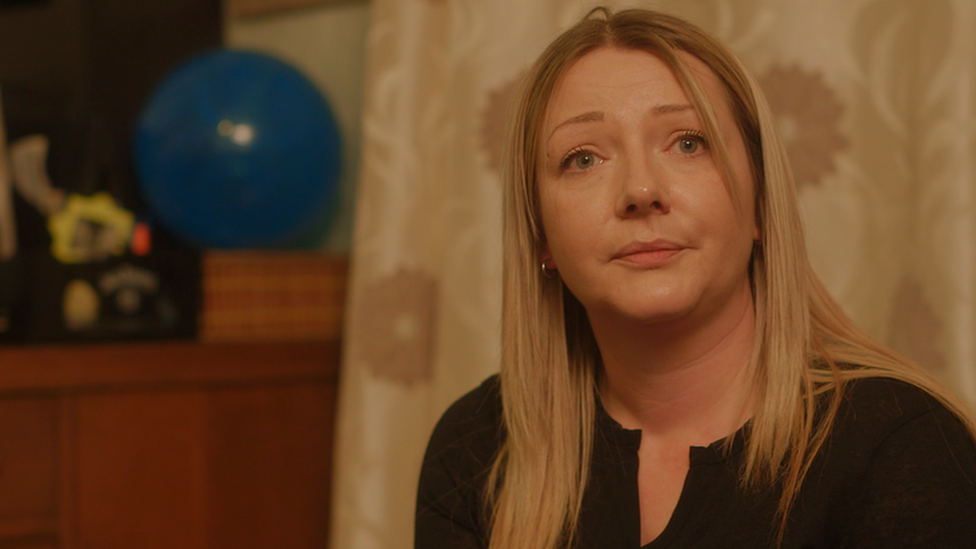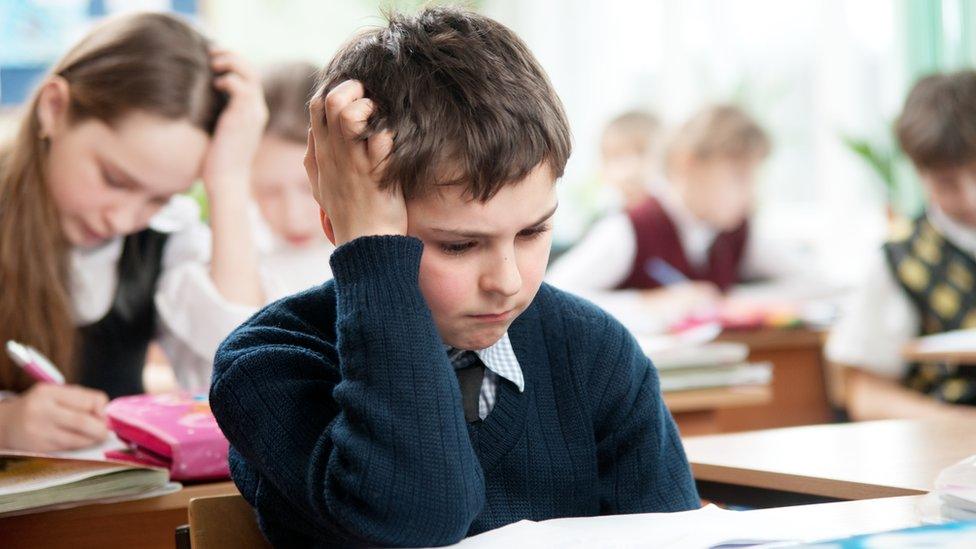'I was locked in a cupboard at school'
- Published
Jacob: 'Every now and then they would open the door and look in at me and close it and leave again'
Parents coping with children whose behaviour is a challenge at home and school have been speaking candidly to BBC Scotland. Here, teenager Jacob explains why he "hates" thinking back to when he was little.

Jacob and his mother Tina admit his extreme behaviour was a big problem but they did not expect his primary school to lock a five-year-old in a store cupboard to calm him down.
He lived in a quiet village in the Stirlingshire countryside, but Jacob was totally overwhelmed when he began school.
He would hide from the teachers, squeak strange noises and often he would lash out.
"I hated it," Jacob, who is now 15, tells the BBC Scotland documentary Help Save My Child.
"I saw all the other people in my class, and they were all working and I couldn't.
"Then I'd get upset over that, and I'd get angry that I got upset and I'd lash out."

Jacob was "overwhelmed" when he started school
Jacob does not know why he behaved like he did.
He and his mother suspect he is autistic, but they have never had a definitive diagnosis.
The teachers could not cope with the child's behaviour and began to put the youngster Jacob in the "chill-out room".
'It was terrifying'
This was a store cupboard with blankets inside. The door was closed and locked.
Tina says: "He was left in there. If there was anything on the shelf he'd destroy it."
Jacob said he was locked in the cupboard "pretty much every day".
He explained: "Every time I acted out in any way, I was straight in there.
"It was awful. It had a window in it but it wouldn't open. They used to have it cracked open a tiny bit, so it was freezing.
"Every now and then they'd come over and open the top of the door and look in at me, and close it and leave again.
"It was terrifying. I was five and locked in a room by myself."

Autism facts and figures
Autism is a lifelong developmental disability that affects how a person communicates with, and relates to, other people. It also affects how they make sense of the world around them.
The number of children identified as autistic in Scottish schools has risen by almost 75% over the last five years - from 8,650 in 2012 to 14,973 in 2017.
Research - from Goldsmith's University - suggests, on average, children wait 3.6 years to receive an autism diagnosis after first seeking professional help.
Research has shown that more than 70% of autistic children have a mental health problem - which can include depression, anxiety or OCD.
Between 2012 and 2017 referrals to Child and Adolescent Mental Health Services (CAMHS) in Scotland increased by 92%. In the same period, the CAMHS workforce increased by 13%.
In the last five years, the number of specialist teachers for children with Additional Support Needs fell by 15%.
Source: The National Autistic Society Scotland


Jacob's mother Tina said the methods used to deal with her son did not help him cope
Stirling Council said its "Time Out" strategy would be instigated to support children to "manage their distress and as a measure to mitigate risks to themselves and others".
It added that it was "committed to providing an inclusive and supportive education experience for all learners"..
At the end of last month, the Children's Commissioner for Scotland launched a formal investigation into restraint and seclusion in schools.
Seclusion is the term used for shutting a child somewhere alone and not allowing them to leave.
The commissioner said seclusion violated a child's right to be free from degrading treatment or punishment.
Its investigation will focus on procedures for recording incidents, which it said was the first step to understanding the scale of the issue.
Charlene Tait, director of autism practice and research at Scottish Autism, said it was "worrying" that it was not known how widespread seclusion was.
She said seclusion could be "extremely counter-productive".
'Anxious and stressed'
Ms Tait added: "If we're just going to isolate the person when they behave in a particular way, we are never really going to get to what is the stress trigger or the anxiety for that child.
"As long as you respond to it in a very superficial way by removing them, you actually run the risk of increasing that behaviour."
She said seclusion risked stigmatising a child and offered no potential for improving their ability to cope.
"What a child might actually need is five minutes to run around the playground and let off steam and then they can relax again," she says.
"Similarly, some individuals like to have things in their hand, objects that comfort them, or they like to have sight of things that are reassuring for them.
"These things are part of a humane approach. They are not about having huge interventions and lots of throwing money at things."
Ms Tait said the consequences of not dealing with issues correctly was that children were too anxious and stressed to go to school, often leading to physical and mental health problems.
The methods used to deal with Jacob did not help him cope and his lashing out became more serious over time.
His mother took him to be assessed by Child Mental Health Services (CAMHS).
Despite regular appointments, he was never given a clear diagnosis that would explain his increasingly extreme behaviour.

Some children find it frustrating that they are unable to work like their classmates
His mother says when he was eight or nine, Jacob would kick her.
"I'm curled up in a ball, and you have to phone somebody to come and help," she says.
"I've had the advice to put bedroom locks on his windows and his door and just leave him in there when he does that, and just let him burn it out. But he would hurt himself."
'Doing better for now'
It upsets him to think of some of the things he has done.
"I hate thinking about when I was little because I was really violent and mean. I'm definitely not like that now that I'm older."
He says he can now see how much his behaviour was affecting his education but also how it "messed up family life".
"We couldn't even go out and have a dinner because I couldn't handle it, I'd get upset and have a tantrum," he says.
Jacob is doing better for now, but the family feel that is despite their contact with school and mental health services and not because of it.
They say they have not had the answers or support they should have.
Tina says: "You expect that when you go for help, somebody will be able to help, point you in the right direction and spend a bit of time. It is not the way it should be."
'Manage distress'
A Stirling Council spokesman said that whether it be a mainstream school or specialised setting, it was important to consider the "care, welfare and safety" of all involved.
He explained; "Staff working in our schools and specialised provisions regularly undertake specialised training. This approach is used in line with the needs of each child or young person.
"The spaces used for Time Out and other purposes are usually small rooms or partitioned areas within a room, often with a window. The rooms are usually kept free of resources and don't have shelves.
"Resources are brought in as required for different activities, which include individual learning in a quiet space, planned time away from the stress of class as a part of the school day, or time-out as a result of behaviour challenges.
"When a child or young person displays distressed/distressing behaviour in school, risk management decisions have to be made and there is close partnership with families to develop individual planning in advance and a clear debriefing process following incidents, enabling this risk management to be well planned and minimising the negative impacts which can occur."